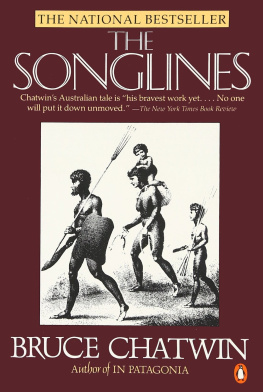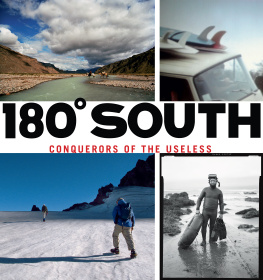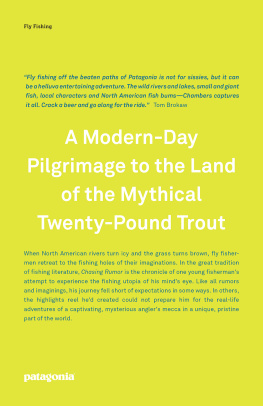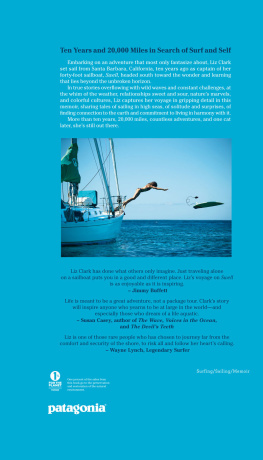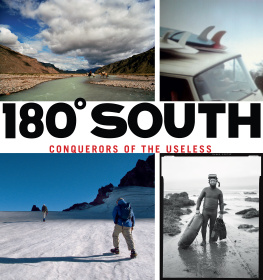It is sure that, if a book is to be readsecond-hand or even in pirated form, its author would prefer it to beread as he or she wrote it. Therefore, from respect for the authorand his considerable book, the two thousand-odd errors wrought by'program' incompatibility have been corrected; any remaining are ofthis editor's deficiency. The author's original text has beenretained, corrected by common sense and scholarship - A publisher andfellow though lesser writer. Nov. '04.
INPATAGONIA
BruceChatwin was born in 1942, and was the author of six books: InPatagonia , TheViceroy of Ouidah, On the Black Hill, The Songlines and Utz .The last three he considered works of fiction. His last book, What AmI Doing Here, is a collection of essays, travelogues, and portraits. Chatwin died outside Nice, France, on January 17, 1989.
InPatagonia
BRUCECHATWIN
Ilny a plus que la Patagonie, la Patagonie,
quiconvienne a mon immense tristesse
BlaiseCendrars
Prosedu Transsiberien
Inmy grandmothers dining-room there was a glass-fronted cabinetand in the cabinet a piece of skin. It was a small piece only, butthick and leathery, with strands of coarse, reddish hair. It wasstuck to a card with a rusty pin. On the card was some writing infaded black ink, but I was too young then to read.
Whats that?
A piece ofbrontosaurus.
My mother knew the names of twoprehistoric animals, the brontosaurus and the mammoth. She knew itwas not a mammoth. Mammoths came from Siberia.
The brontosaurus, I learned,was an animal that had drowned in the Flood, being too big for Noahto ship aboard the Ark. I pictured a shaggy lumbering creature withclaws and fangs and a malicious green light in its eyes. Sometimesthe brontosaurus would crash through the bedroom wall and wake mefrom my sleep.
This particular brontosaurushad lived in Patagonia, a country in South America, at the far end ofthe world. Thousands of years before, it had fallen into a glacier,travelled down a mountain in a prison of blue ice, and arrived inperfect condition at the bottom. Here my grandmothers cousin,Charley Milward the Sailor, found it.
Charley Milward was captain ofa merchant ship that sank at the entrance to the Strait of Magellan.He survived the wreck and settled nearby, at Punta Arenas, where heran a ship-repairing yard. The Charley Milward of my imagination wasa god among mentall, silent and strong, with black mutton-chopwhiskers and fierce blue eyes. He wore his sailors cap at anangle and the tops of his sea-boots turned down.
Directly he saw thebrontosaurus poking out of the ice, he knew what to do. He had itjointed, salted, packed in barrels, and shipped to the NaturalHistory Museum in South Kensington.
I pictured blood and ice, fleshand salt, gangs of Indian workmen and lines of barrels along ashorea work of giants and all to no purpose; the brontosauruswent rotten on its voyage through the tropics and arrived in London aputrefied mess; which was why you saw brontosaurus bones in themuseum, but no skin.
Fortunately cousin Charley hadposted a scrap to my grandmother.
My grandmother lived in ared-brick house set behind a screen of yellow-spattered laurels. Ithad tall chimneys, pointed gables and a garden of blood-colouredroses. Inside it smelled of church.
I do not remember much about mygrandmother except her size. I would clamber over her wide bosom orwatch, slyly, to see if shed be able to rise from her chair.Above her hung paintings of Dutch burghers, their fat buttery facesnesting in white ruffs. On the mantelpiece were two Japanesehomunculi with red and white ivory eyes that popped out on stalks. Iwould play with these, or with a German articulated monkey, butalways I pestered her: Please can I have the piece of brontosaurus.
Never in my life have I wantedanything as I wanted that piece of skin. My grandmother said I shouldhave it one day, perhaps. And when she died I said: Now I canhave the piece of brontosaurus, but my mother said: Oh,that thing! Im afraid we threw it away.
At school they laughed at thestory of the brontosaurus. The science master said Id mixed itup with the Siberian mammoth. He told the class how Russianscientists had dined off deep-frozen mammoth and told me not to telllies. Besides, he said, brontosauruses were reptiles. They had nohair, but scaly armoured hide. And he showed us an artistsimpression of the beastso different from that of myimaginationgrey-green, with a tiny head and giganticswitchback of vertebrae, placidly eating weed in a lake. I wasashamed of my hairy brontosaurus, but I knew it was not a mammoth.
It took some years to sort thestory out. Charley Milwards animal was not a brontosaurus, butthe mylodon or Giant Sloth. He never found a whole specimen, or evena whole skeleton, but some skin and bones, preserved by the cold,dryness and salt, in a cave on Last Hope Sound in Chilean Patagonia.He sent the collection to England and sold it to the British Museum.This version was less romantic but had the merit of being true.
My interest in Patagoniasurvived the loss of the skin; for the Cold War woke in me a passionfor geography. In the late 1940s the Cannibal of the Kremlin shadowedour lives; you could mistake his moustaches for teeth. We listened tolectures about the war he was planning. We watched the civil defencelecturer ring the cities of Europe to show the zones of total andpartial destruction. We saw the zones bump one against the otherleaving no space in between. The instructor wore khaki shorts. Hisknees were white and knobbly, and we saw it was hopeless. The war wascoming and there was nothing we could do.
Next, we read about the cobaltbomb, which was worse than the hydrogen bomb and could smother theplanet in an endless chain reaction.
I knew the colour cobalt frommy great-aunts paintbox. She had lived on Capri at the time ofMaxim Gorky and painted Capriot boys naked. Later her art becamealmost entirely religious. She did lots of St Sebastians, alwaysagainst a cobalt-blue background, always the same beautiful youngman, stuck through and through with arrows and still on his feet.
So I pictured the cobalt bombas a dense blue cloudbank, spitting tongues of flame at the edges.And I saw myself, out alone on a green headland, scanning the horizonfor the advance of the cloud.
And yet we hoped to survive theblast. We started an Emigration Committee and made plans to settle insome far corner of the earth. We pored over atlases. We learned thedirection of prevailing winds and the likely patterns of fall-out.The war would come in the Northern Hemisphere, so we looked to theSouthern. We ruled out Pacific Islands for islands are traps. Weruled out Australia and New Zealand, and we fixed on Patagonia as thesafest place on earth.
I pictured a low timber housewith a shingled roof, caulked against storms, with blazing log firesinside and the walls lined with the best books, somewhere to livewhen the rest of the world blew up.
Then Stalin died and we sanghymns of praise in chapel, but I continued to hold Patagonia inreserve.
THE HISTORY of Buenos Aires iswritten in its telephone directory. Pompey Romanov, EmilioRommel, Crespina D.Z. de Rose, Ladislao Radziwil, and Elizabeta MartaCallman de Rothschildfive names taken at random from among theRs told a story of exile, disillusion and anxietybehind lace curtains. It was lovely summery weather the week I wasthere. The Christmas decorations were in the shops. They had justopened the Pern Mausoleum at Olivos; Eva was in good shapeafter her tour of European bank-vaults. Some catholics had said aRequiem Mass for the soul of Hitler and they were expecting amilitary coup.
By day the city quivered in asilvery film of pollution. In the evenings boys and girls walkedbeside the river. They were hard and sleek and empty-headed, and theywalked arm in arm under the trees, laughing cold laughter, separatedfrom the red river by a red granite balustrade.
Next page

